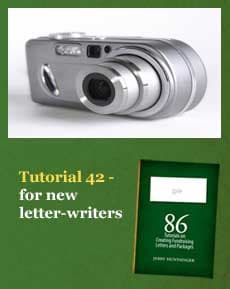Tutorial 42: for new letter-writers.
If you are new to direct mail fundraising, be ready for some surprises. Fundraising by mail is a highly specialised type of marketing.
- Written by
- Jerry Huntsinger
- Added
- January 18, 2019

1) If you are seeking a quiet, non-competitive job, forget it
You will discover that the competition between nonprofit organisations for discretionary funds is intense. Your package and letter will be competing head-on with the package created by your counterpart in the organisation down the street.
2) You can forget job security
You are only as valued as the letter that is producing income right now. Your ultimate boss is a group of volunteer board members who tend to forget your past triumphs and focus only on your current disaster. Each letter you write puts your career on the line.
3) Most of the letters you write are going to be written specifically to women and, in fact, to older women
About 75 to 85 percent of all the money that comes in by direct mail comes from cheques written by women. So you will need to take a crash course in female psychology.
4) Under most conditions, a two-page letter will produce more money than a one-page letter and a four-page letter will produce more than a two-page letter
You probably don’t like to write long letters. When you receive a four-page or six-page letter in your own home, you say, ‘I wouldn’t read anything that long’. After a few months on the job, you won’t say that anymore. You can take my word for it or do your own testing.
And six pages? Eight pages? Don’t fight it. Write long letters if you want a long career.
There are many exceptions and there are times when a one- or two-page letter can be quite effective. When in doubt, write a long letter. The reasoning is too complicated to explore here, but the general principle is: if your prospect finishes your letter and puts it down without being motivated to make a gift, then the letter has not kept her reading long enough.
5) You may be disappointed and frustrated at the type of creativity involved in direct mail
Mail has certain psychological conventions that absolutely must not be violated and you must create within the parameters of those conventions.
You are also restricted by production costs, postage, printing and mail processing. Often the most difficult of all limitations is the editing process. Your letter will probably be ‘improved’ by several individuals. Higher levels of management in nonprofit organisations sometimes tend to be conservative toward creative ideas. That’s not a criticism, just an observation.
6) You will have to become a negotiator
Your letter must first be created, then edited and then negotiated. Learn when to give in and when to compromise.
Letters are generally scanned, not read in their entirety, until the prospect gets hooked. So the beginning and the end are the two vital areas. Don’t compromise a strong beginning or a good closing, compromise in the middle.
7) About five percent of the donors contribute about 75 to 80 percent of the total income
These figures vary from charity to charity. As you begin to understand the principles of list segmentation, you will develop a special fondness for those five percent of the file.
The other shocking statistic – when you go out to the general public and enrol new donors, 50 percent of them will never make a second gift.
8) It is fairly easy to raise money for an emergency, a crisis, or a disaster and it is not too difficult to raise money for a new programme, or to erect a new building
The tough letters are those that attempt to raise money for the organisation’s day-to-day expenses.
If a storm blows the roof off your hospital, the money pours in and you raise enough to put on 10 roofs if you are not careful. But after the roof is up, it’s difficult getting your donors excited about the routine operating costs. Those are the letters that call for real creativity.
9) Buy a camera and learn to use it
Professional photographers rarely produce what you need for good appeals. This will also help you break away from being a wordsmith and get into the area of visual communication. Writers deal with words, but the public wants visuals. A picture is still worth a thousand words.
Your job will not be to write letters. Instead, you will raise money by helping donors visualise the need. Words may be necessary. But pictures convey instant emotion.
10) You will not be composing poetry and words that require contemplation and inspiration
Fundraising letters deal with the harsh realities of our community, our country and our world. Those realities can only be understood if they are experienced.
The purpose of the nonprofit organisation is to receive funds from the public, to manage and administer the funds and, ultimately, to use these funds to help individuals or a group of individuals solve difficult problems.
You need to spend a lot of time at the problem-solving level.
11) Go out and get acquainted with the people who receive assistance from your charity
Find out about their hopes, dreams and fears. Volunteer to work in the field as many hours during the week as you possibly can. If your organisation works overseas, spend your vacation where the action is.
Then, when you write your letters you will not be dealing with statistics, averages and case histories collected by others. Instead, you will be surrounded by memories of a woman crying because her baby is dying, or of a blind father who has never seen his children, but has a chance to survive because of vocational training your organisation is giving him.
This kind of writing is not the cool, detached mail order approach that you see in so many fundraising letters. It is a person-centred, problem-centred expression of the pain and agony that exists in our world.
I hope you survive the first three months on the job.
And when you go to a party, and say you write fundraising letters, expect to be politely shunned. You have occupational leprosy. Don’t expect anyone to really understand – or approve – of what you do for a living.
© SOFII Foundation 2010-2014.

















